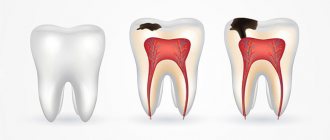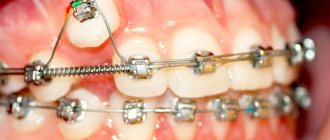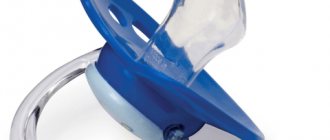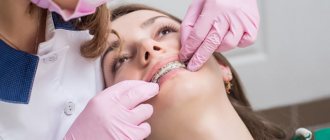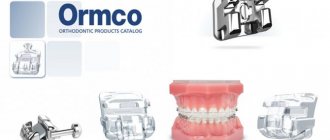Dental braces - what are they, what are they for, and in what cases should they be installed? The design has gained enormous popularity over the past decades. Firstly, this treatment is effective; in a short period of time you can get straight teeth and enjoy a dazzling smile in the mirror. Secondly, there are many types of corrective elements to suit every taste and budget. Thirdly, it is possible to correct orthodontic problems at different ages. Even complex anomalies of the dentofacial apparatus can be corrected.
Let's consider what violations are eliminated in this way, how much time and money it will take.
Pros and cons of braces according to doctors' reviews
Real reviews from doctors about the pros and cons of braces boil down to the fact that the main advantage of these devices is their ability to correct even the most complex malocclusions, unlike other orthodontic devices, and the disadvantage is the difficulty of care and aesthetic qualities (with the exception of certain types of braces) . In addition, experts do not advise choosing braces based on numerous tables on the Internet, which compare treatment periods for different types of braces and prices for these designs. Why?
Firstly, every patient must understand that the degree of impact on the teeth and the duration of the correction process are the same for all braces. This is due to the natural mechanism of tooth movement. Secondly, the following can be said about the cost of braces. There are clinics that offer expensive sapphire braces for the price of ceramic ones. And it's not a joke. It’s just that the cost of orthodontic structures and services for their use depends on the pricing policy of dentistry, and not on the quality of braces or the qualifications of the doctor. Therefore, in our article we will, of course, talk about approximate prices for this or that type of braces, but, basically, we will evaluate bracket systems according to the following criteria:
- aesthetics;
- reliability;
- comfort of wearing;
- ease of care.
Interesting fact!
According to rumors, scientists at Oxford University are working on creating magnetic braces. They say that the principle of their operation will be based on the creation of a constant magnetic field using two miniature generators, which will act on the iron contained in the teeth and effectively correct the bite without the need to wear any structures.
At what age is it better to get braces?
In adolescents aged 13-18 years, the dentition is most susceptible to various changes, so this time is optimal. The treatment will be much faster and painless. However, the structures can also be installed in patients of other age categories.
Malocclusion in children becomes noticeable even when the milk lines appear. Parents should take the child to a pediatric orthodontist so that the doctor can decide whether to install a corrective device. However, before the 12th birthday, there is a high probability of damage to the enamel layer. In addition, pathological changes in insufficiently formed roots are possible, which threatens the loss of incisors, canines and molars. Criteria by which children’s readiness for therapy is determined:
- sufficient enamel strength;
- suitable length of the coronal part;
- presence of anterior molar units.
Some people mistakenly believe that braces are useless for adults. Doctors note that the system can be used until the rows are completely healthy. However, there are some nuances here. The jaws are formed and are no longer so pliable, so the treatment will take a long time. In some cases, removal is required. In adulthood, various problems appear (caries, gum inflammation, thinning of hard tissues), which must be eliminated before the intervention of an orthodontist.
Type of braces
Ligature braces
- the elasticity of the ligatures ensures more comfortable wearing of braces.
- affordable price.
- It is necessary to change the ligatures regularly (about once a month), as they stretch while wearing braces.
- a more complex hygiene procedure due to the presence of ligatures.
Braces without ligatures
- There is no need to replace ligatures, so you can visit the doctor less often.
- Easier oral care routine.
- are more expensive than ligature braces.
Do I need to take care of my teeth after braces?
During treatment, careful oral hygiene is indicated. Rinsing and brushing should be done every time after eating, including snacks. This way the patient gets rid of food particles in the interdental spaces and on the enamel surface.
It is better to use a brush with soft bristles and a small amount of fluoride toothpaste. There are special rinses and flosses (threads) for better care.
When the system is dismantled, the person needs to wear mouthguards (retainers). This consolidates the result obtained. If the aligned units are not maintained, they will soon return to their previous position.
After therapy, the enamel becomes thinner and more vulnerable. Doctors perform remineralization (fluoridation). Plaque and stone are first cleaned off.
To maintain oral health, it is necessary to visit the dentist regularly for preventive examinations. A beautiful smile will last for many years if you regularly care for the soft and hard tissues in your mouth (clean in the morning and evening, after meals, use an irrigator).
Ceramic braces - pros and cons
These orthodontic systems are made from dental ceramics. Having analyzed the pros and cons of non-ligature and ligature ceramic braces, we can conclude that such brace systems represent good value for money, allowing you to solve any bite problems at an affordable price, which in Moscow clinics is about 30,000 rubles for the design itself. one row of teeth. In this case, diagnostics, installation and removal of the system will have to be paid additionally.
Dental braces: what are they?
The design consists of brackets made of metal, ceramics or other materials. The system is attached to the outside or inside of the jaws. All elements are held on a special thin wire.
An orthodontic apparatus is necessary to eliminate pathologies that are associated with incorrect position of teeth. People mistakenly believe that the main purpose of such intervention is the aesthetic appeal of a smile. Doctors do not agree with this and argue that the curvature of incisors, canines and molars is primarily a medical problem, since it often leads to health problems. Food is not crushed enough when chewed, and then poorly digested, as a result of which diseases of the gastrointestinal tract develop.
There are other pathological processes that can only be dealt with with the help of staples. In some cases, extraction is required before installation.
Sapphire braces - pros and cons
These are transparent braces made from artificial sapphire, which really do not spoil the patient’s appearance, but look like a stylish accessory. As for the pros and cons of sapphire braces, their main advantage is considered to be high aesthetics, and a significant disadvantage is the price, since most often they cost much more than ceramic ones. However, there are cheaper options for sapphire designs combined with metal or ceramic. Thus, the cost of braces made entirely of sapphire starts in Moscow clinics from 70,000 rubles per design for one row of teeth.
Let's sum it up
The question of why adults need to get braces on their teeth disappears when the patient becomes familiar with the possible consequences of malocclusion. There are many designs that differ in appearance, material of manufacture, visibility to others, cost and other characteristics. Before settling on a specific option, it is necessary to undergo diagnostic tests and consult with an orthodontist. It is likely that wearing the system in a particular case may be contraindicated, so you need to carefully consider the preparatory measures and listen to the opinions of various highly qualified specialists.
Type of braces
Lingual
- completely invisible.
- as durable as metal systems.
- are more expensive than ceramic braces.
- They are more difficult to maintain than labial systems, which are attached to the outside of the teeth.
- significantly affect diction.
Of course, the above pros and cons of braces will play an important role in shaping your preferences regarding one or another type of these orthodontic structures. However, we will tell you a secret: the best braces for each patient will be those that will help him solve his particular bite problems. Therefore, an experienced and knowledgeable orthodontist will help you choose the right bracket system after examining and diagnosing your teeth.
What do you need to get braces?
First of all, a visual examination is prescribed and diagnostic methods are determined. A treatment plan is then developed. Before installation, oral cavity sanitation, professional reading and other hygienic procedures are carried out. After which the structure is fixed.
How much does it cost
The cost may vary significantly. It depends on the type of system, material, as well as the severity of the pathology. For detailed information, we recommend contacting the dentist by phone listed on the website or leaving a request.
How to install braces if you have implants and crowns
Most patients who turn to orthodontists are adults between 25 and 45 years old. In addition to dental problems, they may have individual units removed and restoration elements may be present. The possibility of installing staples depends on the clinical picture in a particular case.
Inlays and veneers are not a contraindication. However, it is sometimes quite difficult to attach corrective parts to them, so therapy may not give much results.
Locks are also fixed onto artificial crown parts when only the root remains of the unit. If major correction is not required, the restored incisor, canine or molar may not be connected to the system. Experts recommend installing temporary plastic or composite crowns before treatment. They are inexpensive and can be removed if necessary.
If there is an implant, installation of brackets is either undesirable or completely contraindicated. The pin cannot be moved, otherwise it will be rejected by soft tissues. If you leave it in a static position, the remaining units will not be able to move. Thus, therapy is permissible in rare cases when the implanted element does not interfere with the correction of the bite.
Braces and pregnancy - compatible or not
While carrying a child, planning such treatment is strictly not recommended. This is primarily due to the need to undergo X-ray examination (CT, etc.), which is contraindicated in an “interesting position.” In addition, in the first days after installation, to speed up the adaptation process, it is recommended to take painkillers, which is unacceptable for pregnant women.
If therapy has begun and the woman sees two lines on the test, there is no need to remove the staples. However, in this case, you must adhere to the following rules:
- take good care of the oral cavity;
- undergo regular preventive cleaning with a doctor;
- carry out sanitation (preferably before installing braces and pregnancy);
- have the latest X-ray images available to track the dynamics of the correction.
Despite the limitations and undesirability of therapy during gestation, there are obvious advantages of such an intervention:
- in a woman, the structure of the bone tissue changes, and the units shift quickly;
- there is enough time for hygiene procedures;
- you can choose unaesthetic, but the most effective metal accessories, since for a long time you will not have to speak in public and be embarrassed.
How long should you wear braces?
The duration of treatment is determined by the doctor based on the diagnostic results, depending on the severity of the pathology and the selected type of structure. Each case is considered individually; there are no general recommendations.
It is important to remember that before installation it is necessary to get rid of gingivitis, caries, stomatitis and other problems. Therapy lasts at least a year; a shorter period is not enough. There is no maximum limit; some will have to wear braces for several years.
When alignment with braces is not possible
You cannot straighten your teeth using braces if:
- Full or partial edentia. There will simply be nothing to consolidate the basics on.
- Acute mental disorders. A mentally ill person may want to remove the device themselves and cause harm to themselves.
- Diabetes mellitus, severe diseases of the immune and endocrine systems. With these pathologies, the condition of blood vessels and bone tissue worsens. If the tissue becomes inflamed after braces are installed, the tooth may become loose and fall out.
It is also not recommended to install braces if you have bleeding disorders, HIV infection, sexually transmitted diseases, tuberculosis, or oncology. Treatment of malocclusions using braces requires a responsible and competent approach. Therefore, it is very important to entrust the therapy to an experienced and highly qualified doctor.
Making a choice
Many people don't know which dental braces to choose. There is no need to rack your brains over this, as your doctor will help you make the right choice. To do this, he will take into account the characteristics of your oral cavity, age, and your wishes. Based on this, he will decide what to choose and offer it to you.
There are different types of brace systems, and you need to choose the right one based on the duration of treatment and other factors. So, if you plan to wear structures for a long time, it is better to choose ceramic or metal types. If you need to adjust your teeth slightly, you can choose sapphire ones. However, it is worth keeping in mind that this material is quite fragile, so if it is worn incorrectly, it may chip. In this case, you should immediately contact your dentist.
Content:
- The consequences of braces that a person faces while wearing them
- Consequences of braces after removal
- Why problems arise
- How to make treatment as comfortable as possible
Most people are only aware of the positive effects of braces .
They are convinced that after using leveling devices, the bite becomes normal, the smile takes on a more beautiful appearance, and the patient gets a Hollywood smile. But not everyone knows that wearing braces is associated with various risks and very often leads to complications. In this article we will talk about the negative consequences of braces. All people planning orthodontic treatment should be aware of them. Being informed will save you from many problems and disappointments.
How to avoid unpleasant consequences?
Preventing the consequences of wearing braces includes actions such as:
- Careful daily oral hygiene.
During daily procedures, it is important to use not only a brush and toothpaste, but also dental floss, an irrigator, and orthodontic brushes. When brushing your teeth, do not put excessive pressure on the enamel and gums. - Elimination of self-removal of the structure.
Only a dentist should remove the braces system; under no circumstances should you try to dismantle it yourself, even if there is a good reason for doing so. - Timely contact with the orthodontist.
If the structure becomes loose or broken, it is important to contact a specialist as soon as possible. The orthodontist will examine your mouth and, if necessary, your braces.
We hope your orthodontic treatment will be successful, and after the braces are removed, you will be the happy owner of a beautiful smile. Take care of your teeth and remember, ASEPTA products will always help you cope with any dental problem.
Sources:
- The effectiveness of the use of Asept “adhesive balm” and Asept “gel with propolis” in the treatment of chronic generalized periodontitis and gingivitis in the acute stage (Municipal Dental Clinic No. 4, Bryansk, Kaminskaya T. M. Head of the therapeutic department Kaminskaya Tatyana Mikhailovna MUZ City Dental Clinic No. 4, Bryansk
- Report on clinical trials to determine/confirm the preventive properties of commercially produced personal oral hygiene products: mouth rinse "ASEPTA PARODONTAL" - Solution for irrigator." Doctor of Medical Sciences Professor, Honored Doctor of the Russian Federation, Head. Department of Preventive Dentistry S.B. Ulitovsky, doctor-researcher A.A. Leontiev First St. Petersburg State Medical University named after academician I.P. Pavlova, Department of Preventive Dentistry.
- Clinical studies of antisensitive toothpaste “Asepta Sensitive” (A.A. Leontyev, O.V. Kalinina, S.B. Ulitovsky) A.A. LEONTIEV, dentist O.V. KALININA, dentist S.B. ULITOVSKY, Doctor of Medical Sciences, Prof. Department of Therapeutic Dentistry, St. Petersburg State Medical University named after. acad. I.P. Pavlova
- Report on the determination/confirmation of the preventive properties of personal oral hygiene products “ASEPTA PLUS” Remineralization doctor-researcher A.A. Leontyev, head Department of Preventive Dentistry, Doctor of Medical Sciences, Professor S.B. Ulitovsky First St. Petersburg State Medical University named after. acad. I.P. Pavlova, Department of Preventive Dentistry
For children
Our dental prosthetics and orthodontics clinic installs braces not only for adults and teenagers, but also for young children. Which system is best to choose for your child? Usually a system is installed that consists of 20 “locks”. One half is attached at the top, the other at the bottom. Orthodontics considers this treatment to be the most effective. Metal structures are shown for children. After a few years, the braces are replaced with other, more advanced ones, for example, ceramic ones.
What is a retainer?
A retainer is a small arch that is placed on the inside of the teeth after braces are removed. That is, it consolidates the result of treatment of malocclusion. Retainer placement is required for all patients over 25 years of age. You have to wear it for a long time - twice as long as wearing braces. It is believed that the optimal period is four years. After this time, the person must wear a mouthguard at night.
And all these procedures must be performed without fail, otherwise the result of the treatment will not be consolidated. A person must realize that changes in the functioning of the body must be completed. Otherwise, correcting the bite with braces will be done in vain.
Pain after removal
People who have completed treatment to correct their bite and are concerned about pain often come to our orthodontic center. Let us immediately reassure you that you will experience discomfort for no longer than two weeks. Why does this happen - what causes teeth pain? The fact is that over many years the teeth have become accustomed to the position in which they were before treatment. And after removing the braces, they try to return to the incorrect original position.
A person may experience discomfort for another reason - due to weakened enamel. To get rid of discomfort, the doctor applies a special varnish, gel and paste to the teeth. These products quickly restore the enamel, so the pain goes away.
